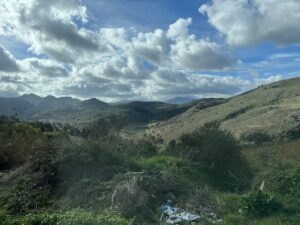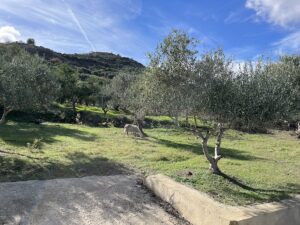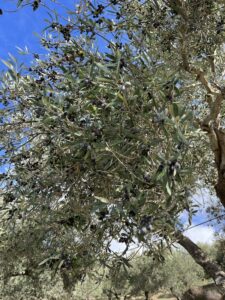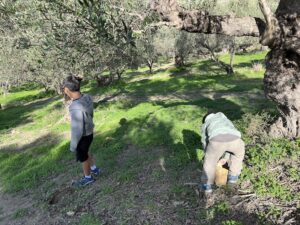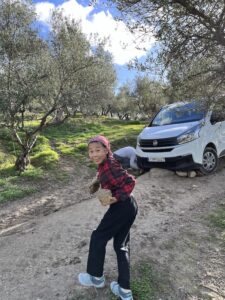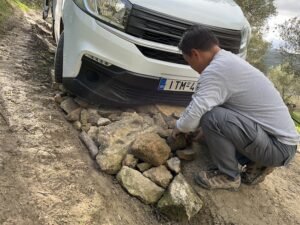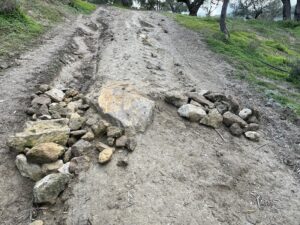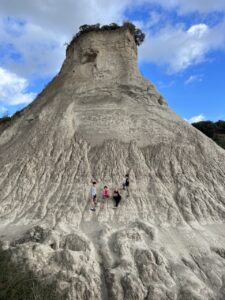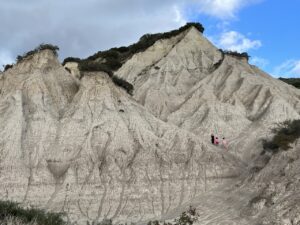We saw photos and were curious to visit a geological phenomenon called Komolithi. It appears to be a pale volcano-like structure with trees and shrubs growing at the top, surrounded by a grassy field. It looks other-worldly and totally out of place on the island of Crete, especially because of the contrast between the lifeless sandy slopes of the structure and the green bushes that grow on top. According to google maps, it didn’t seem so far so we decided to stop by for a look.
To reach Komolithi from Astrika Estate, google maps directed us through what seemed like endless groves of centuries old olive trees. While Leo navigated the roads, I enjoyed the quintessential Cretan scenery that surrounded us. We passed by locals harvesting olives in the traditional way that Chloe from Biolea described. They laid huge green sheets on the ground underneath the trees. Workers used plastic rakes to agitate the tree branches until the fruit fell onto the sheets.
The road was wide enough at the start but gradually, we noticed the roads getting increasingly narrow and rocky. At one point, the road became so narrow that we considered turning back only to realize that we couldn’t turn back because the road was too narrow to allow a U-turn. We were concerned, but we reasoned that at least we were going downhill. Leo cautiously maneuvered the car down the rocky terrain until we came to a part of the road that was so narrow we had to pause and carefully consider our options.
We had passed some olive pickers not far back, so Leo ran back to ask them about the road conditions ahead. He returned quickly and said he knew exactly what to do. The workers had described the road ahead in great detail. In a few moments, we would encounter a narrow road with a small shoulder. It was imperative that we drive on the shoulder, not the main road or else we would get stuck. It had rained a few days ago and the earth was still soft from the rains.
We continued on for a bit and came upon the exact scene that the workers described. Indeed, there was a muddy road with a small shoulder on the side of the hill that was formed presumably by all-wheel drive vehicles trying to avoid the muddy center. Leo followed the man’s instructions and tried to force the two right wheels of our van onto the shoulder. Maybe it was the slippery slope, lack of traction on the tires or lack of speed. Before making it all the way over the shoulder, the van slipped into the muddy road and got stuck. We got off the car to get a better look and discovered that the wheels were spinning in the muddy ditch because the front bumper was caught behind a big protruding rock. What was this rock doing in the middle of the road?
Thoughts raced through my mind: Could a tow truck make it down the narrow path to pull us out? Was there another way out? How far was the nearest town? How many men would it take to pull us out? Would it rain again soon? Was the car damaged? How much would this all cost?
Leo’s mind was racing too. Thankfully, racing in a totally different direction. After a few seconds, he said, “Let’s use rocks to build a ramp.”
Before he finished his sentence, I knew exactly what he meant. And it was brilliant. We needed to get as many rocks as we could find to fill in the ditch under each wheel so the van could move forward while clearing the protruding rock. We got off the car and started collecting rocks from the surrounding olive groves. The kids were excited to be in this situation. There was a concrete (not abstract) problem and we all knew what we had to do to solve it. The kids jumped out of the car to help in the collection effort.
Spirits were high and everybody was hard at work collecting big and small stones. When we turned over the stones, sometimes there were centipedes, spiders and other insects. There were a few slips, scrapes and clumsy attempts, but it was clear to me. This was an amazing scene of a family working together to get out of a bind. There was nobody we could call and nobody who would come to rescue us. It was just us, left to our own devices.
We carefully placed the stones in the ditch, packed as tightly as possible, to minimize any potential shifting of the rocks. We had to be careful that the height of the stones would allow the bumper to clear the height of the protruding rock. At the same time, the angle of the incline of the rock ramp we were building had to be manageable for the van to climb. It wasn’t obvious and we had to use our best judgement to construct the makeshift ramp.
As our family was hard at work, my heart was filled with gratitude for the opportunity to face this challenge together. I didn’t know if our efforts would end in success, but I knew that this would be something the kids and we parents would never forget.
Once we thought the ramp was ready, Leo climbed back into the driver’s seat. We knew we only had one chance to get it right. We were nervous and just hoped it would work. Plan B would take a lot more time, involve more people and carry a big price tag. I stood in front of the car and did my best to direct Leo onto the ramp.
Leo stepped on the gas and the van creaked forward. The rocks shifted and grated against each other under the weight of the car. Just barely, the bumper cleared the protruding flat rock and it was over in a split second.
We cheered like we were champions of the day. Leo and I heaved a sigh of relief that this problem was resolved. It was an exhilarating feeling to triumph over an unexpected setback with no obvious outcome. And to do it as a family only made the victory sweeter.
Back on the road and headed to Komolithi, we had a lengthy conversation with the kids about challenges and setbacks and most importantly, how to deal with them. It wasn’t just a theoretical conversation about what we would or could do in the face of hypothetical difficulties. It was a conversation based on a concrete example that just took place, that we all took part in to arrive at the best solution.
“What would we have done if it didn’t work?” they asked. “We would have come up with another idea.”
We arrived at Komolithi and approached the volcano-like structures through a grassy field. As we got closer, it looked even more like a Martian landscape. It was dusty, but not sandy. It was pale and lifeless, but there were signs of life – trees and shrubs growing on the flat peaks.
The strange-looking formations are not volcanoes or hills, they were actually created thousands of years ago from the erosion of the underlying soft clay soils. According to scientists, millions of years ago, this area was under the sea, which explains the geological composition of the soil. Marine fossils and other under-water geological remains have been found in the area.
The children went off to explore the formations which gave me and Leo a moment alone to appreciate how lucky we are to have each other. We can face any challenge, figure anything out, as long as we are together.
Author
-

Song is the mother of four children. She and her family have stepped away from it all and in September 2023, began traveling the world while homeschooling. Song is an ABC (American born Chinese) and has an undergraduate degree from Cornell and an MBA from Harvard. She is an entrepreneur and an educator. Her hobbies include learning, traveling, reading, cooking and baking, and being with children.



